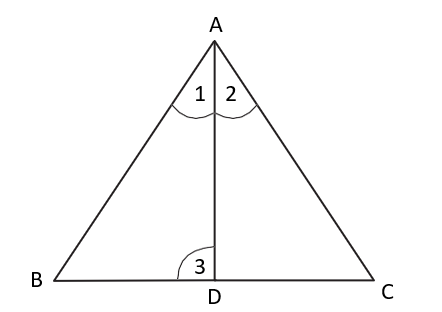ICSE 9 Maths
Isosceles Triangles


Question 1:
In an isosceles triangle ABC, with AB = AC, the bisectors of ∠ B and ∠ C
intersect each other at O. Join A to O. Show that:
(1) OB = OC
(2) AO bisects ∠ A
Question 2:
In Δ ABC, AD is the perpendicular bisector of BC (see fig). Show that Δ ABC is an isosceles triangle in which AB = AC.
Question 3:
ABC is an isosceles triangle in which altitudes BE and CF are drawn to equal
sides AC and AB respectively (see fig). Show that these altitudes are
equal.
Question 4:
ABC is a triangle in which altitudes BE and CF to sides AC and AB are equal (see
fig). Show that
(1) Δ ABE ≅ Δ ACF
(2) AB = AC, i.e., ABC is an isosceles triangle.
Question 5:
ABC and DBC are two isosceles triangles on the same base BC (see Fig).
Show that ∠ ABD = ∠ ACD.
Question 6:
ΔABC is an isosceles triangle in which AB = AC. Side BA is produced to D such
that AD = AB (see Fig). Show that ∠ BCD is a right angle.
Question 7:
ABC is a right-angled triangle in which ∠ A = 90⁰ and AB = AC. Find ∠ B and ∠ C.
Question 8:
Show that the angles of an equilateral triangle are 60⁰ each.
Question 9:
Δ ABC and Δ DBC are two isosceles triangles on the same base BC and vertices
A and D are on the same side of BC (see Fig). If AD is extended to
intersect BC at P, show that
(1) Δ ABD ≅ Δ ACD
(2) Δ ABP ≅ Δ ACP
(3) AP bisects ∠ A as well as ∠ D.
(4) AP is the perpendicular bisector of BC.
Question 10:
AD is an altitude of an isosceles triangle ABC in which AB = AC. Show that
(1) AD bisects BC.
(2) AD bisects ∠ A.
Question 11:
BE and CF are two equal altitudes of a triangle ABC. Using RHS congruence
rule, prove that the triangle ABC is isosceles.
Question 12:
ABC is an isosceles triangle with AB = AC. Draw AP ⊥ BC to show that ∠ B = ∠ C.
Question 13:
In DABC, AB = AC and ÐB = 50°. Then, ÐC is equal to
(a) 40°
(b) 50°
(c) 80°
(d) 130°
Question 14:
In DABC, BC = AB and ÐB = 80°. Then, ÐA is equal to
(a) 80°
(b) 40°
(c) 50°
(d) 100°
Question 15:
In DPQR, ÐR = ÐP and QR = 4 cm and PR = 5 cm.
Then, the length of PQ is
(a) 4 cm
(b) 5 cm
(c) 2 cm
(d) 2.5 cm
Question 16:
In triangles ABC and PQR, AB = AC, ÐC = ÐP and ÐB = ÐQ. The two triangles are
(a) isosceles but not congruent.
(b) isosceles and congruent.
(c) congruent but not isosceles.
(d) neither congruent nor isosceles.
Question 17:
D is any point on side AC of a DABC with AB = AC. Show that CD < BD.
Question 18:
Bisectors of the angles B and C of an isosceles triangle with AB = AC intersect each other at O. BO is produced to a point M. Prove that ÐMOC = ÐABC.
Question 19:
In the given figure, AD is the bisector of ÐBAC. Prove that AB > BD.

Question 20:
Find all the angles of an equilateral triangle.
**********
In summary, problem-solving after learning a theoretical concept on CBSE Isosceles Triangles ICSE 9 Maths is an essential part of the learning process. It enhances your understanding, critical thinking abilities, and retention of knowledge. Moreover, it equips you with valuable skills that are applicable in academic, personal, and professional contexts.
You must have heard of the phrase “Practice makes a man perfect”. Well, not just a man, practice indeed enhances perfection of every individual.
Practicing questions plays a pivotal role in achieving excellence in exams. Just as the adage goes, "Practice makes perfect," dedicating time to solve a diverse range of exam-related questions yields manifold benefits. Firstly, practicing questions allows students to familiarize themselves with the exam format and types of problems they might encounter. This familiarity instills confidence, reducing anxiety and improving performance on the actual exam day. Secondly, continuous practice sharpens problem-solving skills and enhances critical thinking, enabling students to approach complex problems with clarity and efficiency. Thirdly, it aids in identifying weak areas, allowing students to focus their efforts on improving specific topics. Moreover, practice aids in memory retention, as active engagement with the material reinforces learning. Regular practice also hones time management skills, ensuring that students can allocate appropriate time to each question during the exam. Overall, practicing questions not only boosts exam performance but also instills a deeper understanding of the subject matter, fostering a holistic and effective learning experience.
All About Daily Practice Problems on ICSE 9 Maths Isosceles Triangles NCERT Chapter 10
Our Daily Practice Problems (DPPs) offer a diverse range of question types, including Multiple Choice Questions (MCQs) as well as short and long answer types. These questions are categorized into Easy, Moderate, and Difficult levels, allowing students to gradually progress and challenge themselves accordingly. Additionally, comprehensive solutions are provided for each question, available for download in PDF format - Download pdf solutions as well as Download pdf Questions. This approach fosters a holistic learning experience, catering to different learning styles, promoting self-assessment, and improving problem-solving skills. With our well-structured DPPs, students can excel in exams while gaining a deeper understanding of the subject matter. Hope you found the content on ICSE 9 Maths Isosceles Triangles NCERT Chapter 10 useful.
Last but not least, to get the best hold on ICSE 9 Maths Isosceles Triangles NCERT Chapter 10, do not forget to check out: